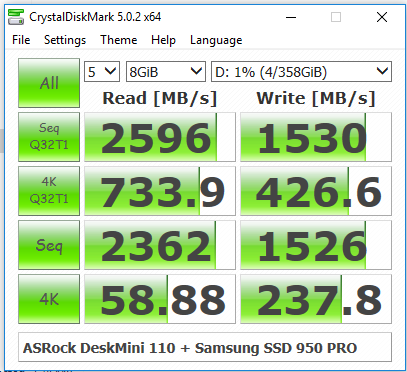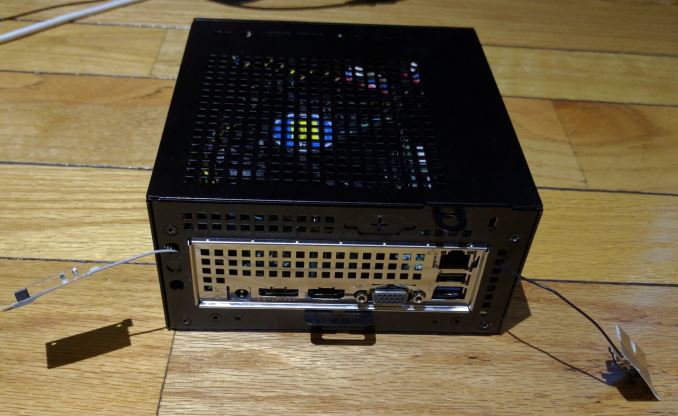ASRock DeskMini 110 mini-STX PC Review
by Ganesh T S on June 8, 2016 8:45 AM ESTNetworking and Storage Performance
Networking and storage are two major aspects which influence our experience with any computing system. This section presents results from our evaluation of these aspects in the ASRock DeskMini 110. On the storage side, one option would be repetition of our strenuous SSD review tests on the drive(s) in the PC. Fortunately, to avoid that overkill, PCMark 8 has a storage bench where certain common workloads such as loading games and document processing are replayed on the target drive. Results are presented in two forms, one being a benchmark number and the other, a bandwidth figure. We ran the PCMark 8 storage bench on selected PCs and the results are presented below.


Despite using the same SSD, we do see some difference in scores between Skull Canyon and the DeskMini. This probably results from differences in the CPU capabilities, since the storage bandwidth actually reflects the amount of time that the CPU was waiting on at least one I/O request to the disk.
The important aspect to test from the DeskMini viewpoint is PCIe 3.0 x4 support (since the H110 has only PCIe 2.0 support). We ran the quick CrystalDiskMark check and could see that the Samsung SSD 950 PRO showed its quoted performance numbers.
On the networking side, we restricted ourselves to the evaluation of the WLAN component. Our standard test router is the Netgear R7000 Nighthawk configured with both 2.4 GHz and 5 GHz networks. The router is placed approximately 20 ft. away, separated by a drywall (as in a typical US building). A wired client is connected to the R7000 and serves as one endpoint for iperf evaluation. The PC under test is made to connect to either the 5 GHz (preferred) or 2.4 GHz SSID and iperf tests are conducted for both TCP and UDP transfers. It is ensured that the PC under test is the only wireless client for the Netgear R7000. We evaluate total throughput for up to 32 simultaneous TCP connections using iperf and present the highest number in the graph below.

In the UDP case, we try to transfer data at the highest rate possible for which we get less than 1% packet loss.

Our main aim with the WLAN component was to show that the DeskMini could indeed support a M.2 PCIe WLAN module. Intel actually provided us with a AC8260 card meant for the Skull Canyon NUC. Therefore, the antenna type we got was really not a good fit for the all-metal chassis. We ended up doing the above evaluation with the antennae not mounted to the chassis, but just hanging out of the system. Despite this unwieldy setup, the system had no trouble getting good numbers in our bandwidth test.
The DeskMini chassis does provide three perforations diagonally across the M.2 WLAN slot in the rear to install screw-type antennas. Consumers can keep this in mind while hunting for the appropriate WLAN component to complete a DeskMini build.












85 Comments
View All Comments
Lolimaster - Saturday, June 11, 2016 - link
I would really love a review of the i7 6700T 35w.i7 6700K is only 17% faster on average without that nice tdp. Powerconsumption idle/load/typical use/temps. Would really appreciate it.
prisonerX - Tuesday, June 14, 2016 - link
A reasonably priced case with built-in passive CPU heatsink would be a nice complement in that review. With Skylake about the only real benefit is the practicality of silent PCs.prisonerX - Tuesday, June 14, 2016 - link
This ticks a lot of boxes:small size, 12V power, Skylake. But $130 for a motherboard, a generic power brick and a simple case? Seriously?8steve8 - Saturday, July 9, 2016 - link
I know right? It should be like $300 considering the skull canyon NUC is over $600 and can only handle a 45w CPU... With a terrible (loud) cooler.There is nothing that competes with this: Skylake 65 W with this size.
If only Intel would release a socketed Skylake 65w CPU/iGPU with eDRAM.
ES_Revenge - Friday, June 17, 2016 - link
Really don't understand the point to STX. Has zero slots, okay that makes it even smaller than ITX but is there really a need for it? The NUC/mini-PC type jobbies like the NUC, Cubi, Liva, etc. seem to have their market covered. If you really want there are some very small mini-ITX cases (some that even only hold thin mini-ITX) and don't end up using the slot so the space "wasted" because of it isn't that much.For example Antec's ISK 110 is very small, it's a bit bigger than this but it uses mini ITX boards (with no slot usability) which are available all over the place. It just doesn't seem like we need another form factor to be between mini ITX and the NUC-type machines, does it?
I'd rather mini DTX have taken off that this. I just don't think there's a need for mini-ITX minus like 5cm
8steve8 - Saturday, July 9, 2016 - link
Most NUCs have a 15W or less CPU meant for laptops... With a laptop style heatsink/fan.This takes a 65w CPU and a quieter heatsink/fan.
Imagine you want a very high performance desktop, but also want it as small as possible. I realize most commenters on this site are obsessed with game performance, but if you don't care about playing the latest game, then this pretty close to the perfect high performance small desktop workstation.
8steve8 - Saturday, July 9, 2016 - link
This is much smaller than even tiny itx PCs ... Also front ports without internal wires/connectors!jaydee - Thursday, June 30, 2016 - link
The power draw for the MSI Cubi 2 Plus vPro max load power draw (Prim95 + FurMark) really can't be right. It's a 35W TDP i5-6500T, and according to the chart is measuring 10W higher than the 65W i5-6500 PC in this review?The i5-6500T 35W PC almost has to be closer to half of the 102W shown here (which was taken from the MSI Cubi 2 Plus vPro main article).
butchooka - Friday, August 12, 2016 - link
Can please someone confirm tha it is possible to install 15mm high HDDs?Would be a nice to put 2*4TB 2,5 drives +m2-SSD in it.
Found nowhere information about possible high of drives in this case, or pics showing there is enogh space. All tests only use ssd drives with 6/9,5mm height. Asrock only provides that it has space for 2 drives
james.shallcross - Tuesday, September 20, 2016 - link
7mm - no problem9.5mm - will JUST fit
15mm - will not fit